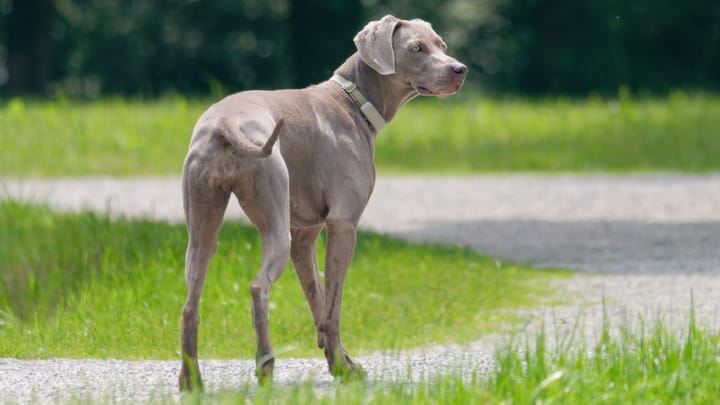Weimaraner


The Weimaraner has a majestic appearance, notably because of his grey coat that sometimes borders on blue. It is an excellent pointing dog, and is otherwise very versatile, capable of satisfying many a prospective owner. A wonderful family dog, he also gets along well with children and greatly appreciates all displays of affection bestowed upon him. This german dog will be best suited to active and dynamic owners, ready to meet his significant expenditure needs.
|
Life expectancy |
The Weimaraner has a life expectancy of between 10 and 12 years |
|
Temperament |
|
|
Size |
Medium
|
|
Adult size |
Female
Between 22 and 26 in
Male
Between 23 and 28 in
|
|
Adult weight |
Female
Between 55 and 77 lb
Male
Between 66 and 88 lb
|
|
Coat colour
Admissible coat colours are silver-grey, brown-grey and mouse-grey. All variations of these colours are accepted as well. The head and ears of the dog are generally lighter. White patching is only occasionally admissible. Tan patching (from red to yellow) is not sought after and tan-brown patching constitutes an important defect by official standards. |
Blue |
|
Type of coat
Two varieties exist: the short-haired Weimaraner and the long-haired Weimaraner. For short-haired Weimaraners, the coat is dense, very thick and lies flat. The undercoat is very light, almost absent. The mixed individuals have a double coat that consists of a top coat that is medium-length, concentrated, lies flat and has an abundant undercoat. |
Long Very short |
|
Eye colour
The eyes are amber; in pups, the colour is light blue. |
Blue
Brown
|
|
Purchase price |
The Weimaraner costs between £730 and £900 |
In certain countries, such as Brazil, the Weimaraner is employed in various missions, oftentimes by the police force. He is particularly appreciated for his competence as a search dog due to his incredible sense of smell.
More details about the Weimaraner
Weimaraner: Origins and history
It remains uncertain whether this dog was born precisely in Weimar, the town being his namesake, but it is certain that it originated in Germany. The Bloodhound may arguably be his only ancestor, either directly, or via the Grey St. Louis Hound, which no longer exists today. He had allegedly arrived in Germany after crossing the Rhine towards the 15th century. According to other accounts, it was originally a local breed, resulting from a cross of the Weimaraner’s short-haired ancestors (Kurzhaar) and other hunting breeds.
Physical characteristics of the Weimaraner
The Weimaraner is a medium to big-sized dog, with a typical pointer constitution: an elongated body, slim and slightly arched neck, well-built and tucked in sides, strong limbs. The head is well-defined, with a noble side profile and a slightly pronounced stop. The ears are large, relatively long, with round tips and set high and narrow: they are slightly turned to the front when the dog is stimulated. The tail is shortened.
FCI classification of the Weimaraner
-
Group 7 - Pointing Dogs
-
Section 1 : Continental Pointing Dogs
Weimaraner: Characteristics
Weimaraner: Behaviour
Training a Weimaraner
This hunting dog can prove himself to be stubborn and somewhat pigheaded if he feels that his leader is not confident and authoritative enough. At times quite proud, the Weimaraner can grow docile if an environment of trust is cultivated.
Training must be precocious, to prevent the dog from picking up bad habits, and firm so as to create a structure for the dog and make him feel safe.
Some rules of conduct must be implemented to integrate this big dog as smoothly as possible into the household, as he will not accept exclusion from family life.
Positive reinforcement training methods should absolutely be used, otherwise this seemingly noble dog’s sensitivity could be vexed.
Weimaraner: Lifestyle
Breed compatibility Weimaraner
Weimaraner: Purchase price
The price of a Weimaraner varies depending on its origins, age, and gender. You have to count an average of £900 for dogs subscribed to the Kennel Club.
With regards to the monthly budget required for a dog of this size, including both quality nutrition and basic yearly care (vaccinations, deworming, etc.), it is estimated at around £45.
Weimaraner: Shedding
Average
Hair loss is moderate but remains nevertheless significant during annual moulting seasons, such as spring and autumn. Daily brushes will then have to be provided for the dog.
Weimaraner: Grooming
This hunting dog’s short and dense coat does not need to be maintained in an extensive manner. Weekly brushes will be sufficient to maintain the beauty of his grey coat.
Eyes and ears will have to be checked regularly and treated in order to avoid risks of infection.
Weimaraner: Health
Life expectancy is estimated at 11 years.
The Weimaraner is of robust constitution but remains, like many dogs of his size, relatively fragile, especially during his growth.
Moreover, given that he is so active and athletic, his meals must be supervised in order to prevent potential medical issues. His fragility is additionally reinforced by the lack of an undercoat.
Be sure not to stimulate this big dog during intense heat. Passionate about hunting and determined when in action, he might keep going until the point of collapse without being conscious of it.
Regulated activity, unlimited water and a spot in the shade will therefore be necessary when the weather is hot.
In fact, the Weimaraner greatly appreciates water: water games and walks alongside waterfronts could be a wonderful solution for this dog in the summertime.
This pointing dog is particularly robust and very enduring when at work. That being said, he does not have an undercoat (or only a very thin layer of it), which does not equip him well for extremely cold weather.
In addition to preventing excess weight, it is very important not to feed this big active dog in between meals, if he is getting a lot of physical exercise. This could lead to gastric torsion syndrome.
Snacks are however recommended during training sessions, but must be handed out modestly to avoid excessive weight gain.
A Weimaraner who does not get enough exercise can rapidly gain weight. Decent, regular walks will help avoid this potentiality.
- Gastric torsion syndrome
- Hip and elbow dysplasia
- Renal dysplasia
- Umbilical hernia
- Skin problems (skin asthenia
- Distichiasis / trichiasis (lash anomalies)
- Wobbler syndrome (compression of the spinal cord at neck level)
- Corneal dystrophy of epithelial surface
- Eversion of the nictitating membrane
- Entropion
- Tumours (mastocytoma, lipoma, etc.)





